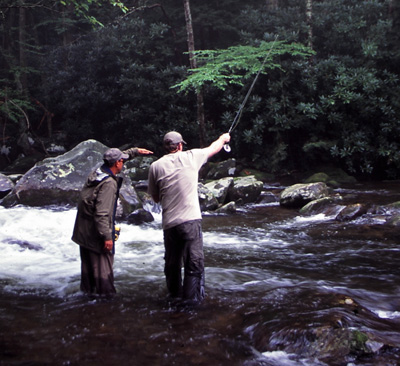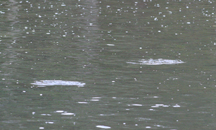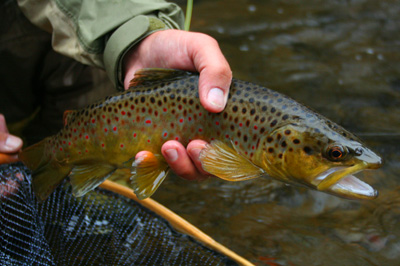Our job as fly fishing guides is to help anglers catch fish. Most of the people who fish with us are competent casters, have decent equipment, and can find good flies on their own. In spite of the fact that they have most of the tools to catch fish, they lack the knowledge to use the equipment to its fullest potential.
Our job as guides is to direct anglers to catch fish. Sometimes we come up with creative ways to get a point across. Regardless of whether we’re fishing small brook trout streams high in the Smokies or floating down a big tailwater in a driftboat we can distill the main concept to one word: Wait!
In the truest sense, fly fishing is a predatory exercise; the same as hunting. We catch fish through deception while hunters take down a deer or bird with a gun, but there are more similarities than you might think. A hunter does NOT just walk through the woods blasting a rifle or shotgun as he goes. He has to wait for the shot. There are times when a hunter sees a deer or a bird, but doesn’t take the shot. It’s either too far or isn’t a clear shot, so he waits for a better opportunity.
This can apply to fly fishers too. How many times have you waded up a stream, casting as you go with no real target? This alerts fish to your presence and diminishes your chances of catching trout. An angler will do far better to simply wade into position and decide where to cast. Sometimes it helps to move a step or two further to get in the best position for a good drift. This sets the angler up for the best shot before he casts.
Trout live in moving water. If you think about it, they only see food once before they eat it. If a real bug comes down the river and a trout doesn’t eat it, he never will. The bug only floats by once. If an angler makes a cast from a bad position there is a good chance the fly will drag or the cast will alert the fish to danger. The first time the fish sees the fly he knows it isn’t real.
On the other hand, if the angler casts from the best position possible there is a good chance the cast will be a good one. A trout is likely to eat a fly on the first cast if it has a good drift. Hunters rarely get a second shot. Deer or birds take flight and the opportunity is gone. This happens with trout too, but many anglers don’t realize this since they never saw the fish in the first place.
Most nights after guide trips we tell each other about our day on the water. One of the most common recurring stories is when an angler misses a strike and says, “I didn’t expect one to be there!” Of course we told them to put the fly there, but even if we didn’t we always like to ask, “Then why did you put it there?”
A hunter never shoots his rifle at random, only to be surprised that he hit something. A fly fisher should be the same way. It’s a simple concept, almost too simple, but only cast the fly when you think you’ll get a strike. Our motto is “Be surprised when a fish doesn’t eat your fly. Never be surprised when you get a strike.”
Most anglers see a pod of rising trout as a sure thing. The best way to fish over a group of fish is to pick one and fish to it. There are two ways to pick a fish. You can either choose the one you think is biggest or choose the one you think is the easiest to catch. In either case you should focus on that one fish. Most anglers cast at the whole group. This often results in the fly drifting between fish instead of drifting to a fish.
Treat your fly rod like a loaded gun and you’ll catch more fish. Choose you casts wisely and don’t cast indescriminately. Position yourself for the best opportunity and don’t cast until you know you’ll make a good one. If you follow those rules you should get more strikes, so don’t be surprised by your success. Enjoy it!






Neal says
I really enjoy reading your fishing reports and your fishing methods articles as well. I have seen you several times on the Holston and Little River, but didn’t have the opportunity to talk to you. I also have your book on fishing the Smokies and the Tennessee Guide to Trout fishing. I use both these books a great deal to discover new water and with fishing methods as well. I’ll have to order your new brook trout book. I’m sure it will be a fine read as well.
The Trout Underground says
Flock shooting a pod of rising fish is little more than a one-way ticket to a prozac prescription; Ian’s very “predatory” approach to the sport is not only effective, it’s also very zen.
Ryan says
I too will agree… This concept is the perfect way to convey being selective with your cast. Another possible term one could use: “Patience.”
This will be a huge improvement over my old method: “get fly in water ASAP.”
Thanks Ian,
…Patiently waiting for Spring
Mike in Indy says
The phrase “flock shoot” really puts this into perspective. As a hunter I always wait for the best shoot and stalk probably more than necessary. Spotting fish is where I need practice.
Looking forward to spring fishing.
Collin in Texas says
Another GREAT long-distance lesson. I have never thought about the idea of really looking at the water for several minutes before a cast is made, but it makes perfect sense.
Spring can’t come fast enough.
As always, Thanks Ian!
Andy Roth says
Ian
As I sit here at my computer after 88 hours in the sub-zero and anxious for our trout season in Wisconsin to start, I look for useful information to help make me a better angler and guide. Thanks for providing me with a great tip to use during upcoming season. Your site is loaded with great information and it is a pleasure to read. I have always found that the relationship between guide and client can make or break the trip. The use of analogies has always been a key factor in getting my clients to understand what I would like them to do. By taking the time to learn a little about the clients interests, a good teacher can convey his or her thoughts through these similarities. This alone can build the foundation for lasting relationships and successful angling skills.
Thanks Ian
Andy Roth- Gray Goat Fly fishing